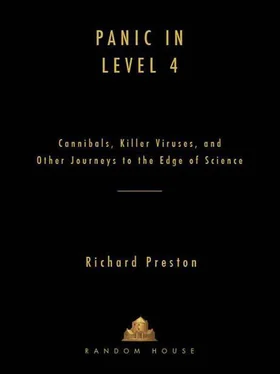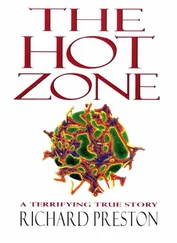* * *
WILLIAM NYHAN was eighty-one, a tall, fit-looking man with sandy-gray hair and blue eyes. He ran marathons until he was about seventy, half marathons after that; he was now the top-seeded tennis champion in his age class in southern California. He had a laboratory overlooking a wild canyon near the U.C. San Diego Medical Center. One day when I visited him, the Santa Ana wind was blowing in from the desert, and the air had an edgy feel. Two red-tailed hawks were soaring over the canyon, tracing circles in the air. The distinct movements of the hawks revealed a pattern of flight engraved in the birds’ genetic code.
In the years since he had identified Lesch-Nyhan, William Nyhan had discovered or codiscovered a number of other inherited metabolic diseases, and he had developed effective treatments for some of them. He had figured out how to essentially cure a rare genetic disorder called multiple carboxylase deficiency, which could kill babies within hours of birth, by administering small doses of biotin, a B vitamin. Lesch-Nyhan, however, had proved to be more intractable.
Decades after the discovery of Lesch-Nyhan syndrome, it is still mysterious. It is perhaps the clearest example of a change in the human DNA that leads to a striking, comprehensive change in behavior. In 1971, William Nyhan coined the term “behavioral phenotype” to describe the nature of diseases like Lesch-Nyhan syndrome. A phenotype is an outward trait, or a collection of outward traits, that arises from a gene or genes—for example, brown eyes. Someone who has a behavioral phenotype shows a pattern of characteristic actions that can be linked to the genetic code. Lesch-Nyhan syndrome seems to be a window onto the deepest parts of the human mind, offering glimpses of the genetic code operating on thought and personality.
* * *
H. A. JINNAH, a neurologist at Johns Hopkins Hospital, has been studying Lesch-Nyhan syndrome for more than fifteen years. “This is a very horrible disease, and a very complex brain problem,” he said to me one day in his office. “It is also one of the best models we have for trying to trace the action of one gene on complex human behavior.”
A child born with Lesch-Nyhan syndrome seems normal at first, but by the age of three months has become a so-called floppy baby, and can’t hold up his head or sit up. His diapers may have orange sand in them, and his body begins a pattern of writhing. When the boy cuts his first teeth, he starts using them to bite himself, especially at night, and he screams in terror and pain during these bouts of self-mutilation. “I get calls in the middle of the night from parents, saying, ‘My kid’s chewing himself to bits, what do I do?’” Nyhan said. The boy ends up in a wheelchair, because he can’t learn to walk. As he grows older, his self-injurious behaviors become subtle and more elaborate, more devious. He seems to be possessed by a demon that forever seeks new ways to hurt him. He spits, strikes, and curses at people he likes the most—one way to tell if a Lesch-Nyhan patient doesn’t care for you is if he’s being very nice. (He wishes you would go away, so the Lesch-Nyhan part of him tries to keep you near him.) He eats foods he can’t stand; he vomits on himself; he says yes when he means no. This is self-sabotage.
A few hundred boys and men alive in the United States today have been diagnosed as having Lesch-Nyhan syndrome. “I think I know most of them,” Nyhan said. A boy known as J.J. whom Nyhan found in a state institution, where he’d been considered spastic and mentally retarded, ended up living in Nyhan’s research unit for a year. He was a lively, gregarious child whose hands seemed to hate him with a demonic precision. Over time, his fingers had gotten into his mouth and nose, and had broken out and removed the bones of his upper palate and parts of his sinuses, leaving a cavern in his face. He had also bitten off several fingers. J.J. seemed happy most of the time, except when he was injuring himself.
J.J. died in his late teens; in the past many Lesch-Nyhan patients died in childhood or their teens, often from kidney failure. (Both Morlen brothers died young.) Nowadays they may live into their thirties and forties, but they often die from infections like pneumonia. Occasionally, a man with the disease flings his head backward with such force that his neck is broken, and he dies almost instantly.
A Lesch-Nyhan person may be fine for hours or days, until suddenly his hands jump into his mouth with the suddeness of a cobra strike, and he cries for help. People with Lesch-Nyhan feel pain as acutely as anyone else does, and they are horrified by the idea of their fingers or lips being severed. They feel as if their hands and mouths don’t belong to them, and are under the control of something else. Some Lesch-Nyhan people have bitten off their tongues, and some have a record of self-enucleation—they have pulled out an eyeball or stabbed their eye with a sharp object such as a knife or a needle. (The eye is a soft target for the hand of a Lesch-Nyhan person.) When the Lesch-Nyhan demon is dozing, they enjoy being around people, they like being at the center of attention, and they make friends easily. “They really are great people, and I think that’s part of the disease, too,” Nyhan said. Some Lesch-Nyhan people are cognitively impaired and others are clearly bright, but their intelligence can’t be measured easily. “How do you measure someone’s intelligence if, when you put a book in front of him, he has an irresistable urge to tear out the pages?” Nyhan said.

J.J., one of the earliest Lesch-Nyhan patients diagnosed by William L. Nyhan. His fingers pulled out the bones of his upper palate and sinuses, while his teeth removed several fingers. The bumps at the top of his ear were caused by gout; they are deposits of uric acid crystals known as tophi. J.J. was an outgoing child, very popular with his caregivers. He may be smiling in this picture, and he seems to have closed his eyes in anticipation of the camera flash.
William L. Nyhan
* * *
IN 1967, J. EDWIN SEEGMILLER, a scientist at the National Institutes of Health, and two colleagues discovered that in Lesch-Nyhan patients a protein called hypoxanthine-guanine phosphoribosyl transferase, or HPRT, which is present in all normal cells, doesn’t seem to work. The enzyme is especially concentrated in deep areas of the brain, around the brain stem. The job of this enzyme is to help recycle DNA. Cells are constantly breaking DNA down into its four basic building blocks (represented by the letters A, T, C, and G, for adenine, thymine, cytosine, and guanine). This process produces compounds called purines, which can be used to form new code. When HPRT is absent or doesn’t work, purines build up in a person’s cells, where they are eventually broken down into uric acid, which saturates the blood and crystallizes in the urine.
In the early 1980s, two groups of researchers, one led by Douglas J. Jolly and Theodore Friedmann, decoded the sequence of letters in the human gene that contains the instructions for making HPRT. It includes 657 letters that code for the protein. Researchers also began sequencing this gene in people who had Lesch-Nyhan. Each had a mutation in the gene, but, remarkably, nearly everyone had a different one; there was no single mutation that caused Lesch-Nyhan. The mutations had apparently appeared spontaneously in each affected family. And in the majority of cases, the defect consisted of just one misspelling in the code. For example, an American boy known as D.G. had a single G replaced by an A—one out of over three billion letters of code in the human genome. As a result, he was tearing himself apart.
Читать дальше









![Shin_Stark - В подземелье я пойду, там свой level подниму X [СИ]](/books/384602/shin-stark-v-podzemele-ya-pojdu-tam-svoj-level-po-thumb.webp)



